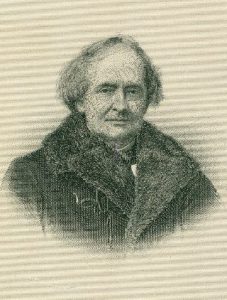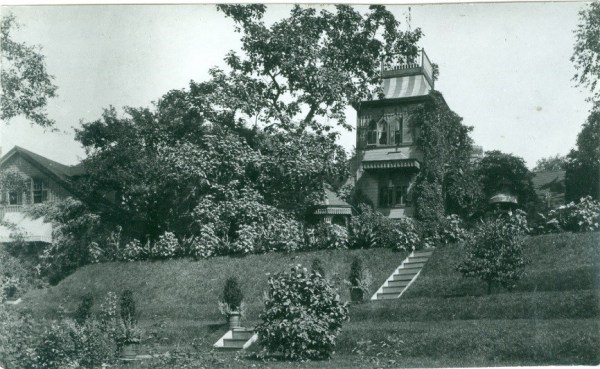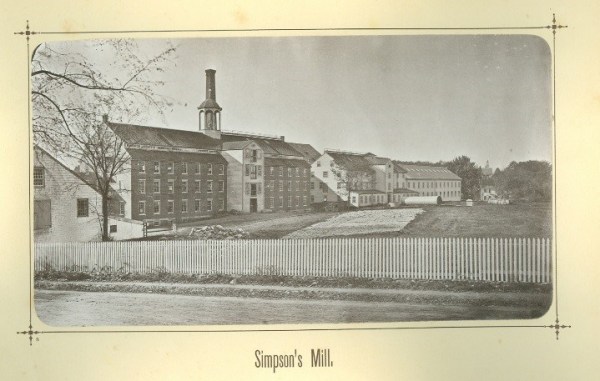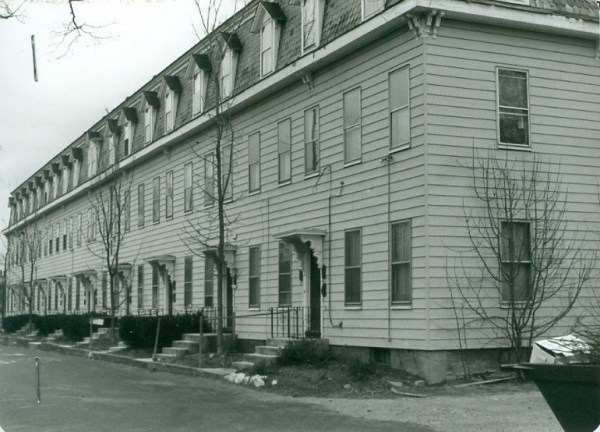Michael Hodge Simpson (1809-1884) was a nineteenth century businessman and inventor. He was born in Newburyport, Massachusetts on November 15, 1809, the son of sea captain and merchant Paul S. Simpson and Abigail (Johnson Hodge) Simpson. Eager to pursue a career in trade, Michael left school in his mid-teens to work as a clerk in Adams and Emery’s commission house in Boston. A few years later, when the Adams and Emery house went out of business, he went to work for the mercantile firm of Jonathan Emery & Son. It was during this time that he and a fellow clerk by the name of Charles Henry Coffin became involved in making “small deals” buying and selling hides, wool, and horns in Calcutta, India and Buenos Aires, Argentina. These “small deals” soon became “big deals” which led Simpson and Coffin to establish their own import business – all before the age of twenty-one years!

Michael Simpson married Elizabeth Davies Kilham of Boston in 1833. The couple had five children, only three of whom survived their parents. When in Framingham, the family live in an impressive hillside mansion called Chestnut Cottage at 50 Elm Street in Saxonville. The family also maintained a home at 6 Ashburton Place in Boston, and a seaside cottage on Plum Island, Newburyport.
By the age of twenty-six, Simpson’s professional life took a new path. He went from import merchant, to inventor, and finally to woolen manufacturer. Purchases of one million pounds of dirty, raw, low-grade wool had accumulated in his warehouses. The raw wool was burr-filled and needed to be cleaned before it could be sold. In the past, deburring wool had been done by hand, but it was too expensive. So Simpson began to search for a deburring machine. He finally chose an invention that had been developed by Samuel Couillard, Jr. of Boston. He then set up his own mill, the Simpson Worsted Mill in Lowell, Massachusetts. Not completely satisfied with Couillard’s design, Simpson worked diligently to improve the machine. At last he had success when he created a machine that no longer cut the fibers as it removed the burrs. On July 7, 1835, he was issued a patent for his new invention. The Simpson Worsted Mill product lines included bunting, and blanket and worsted yarns. In 1833 after the death of his partner, George H. Otis, Simpson sold his import business to Whitehall, Bond & Co., the owners of the Saxon Factory. He moved his woolen shop and machinery from Lowell to Saxonville in early 1837. He became part owner of the Saxon Factory, which was owned by New England Worsted Company. During the Panic of 1837, Simpson, as principle creditor, took over management of the Saxon Factory and the New England Worsted Company.

During the 1850s, Simpson partnered with John Johnson, a mill owner from Troy New York to produce tapestry carpets. Simpson bought out the bankrupt Roxbury Carpet Company, and moved Johnson’s tapestry carpet looms to the mills in Roxbury, Massachusetts. Johnson was hired to manage the plant. The tapestry carpet line proved to be very successful and was produced by the company until its closing in 1973. The Panic of 1857 brought further changes to the ownership of the Roxbury Carpet Company and the Saxonville mills. The Saxonville mills once again failed, and Simpson with Nathaniel Francis stepped in and purchased both companies.
During the Civil War, 1861-1865, the factory shifted from production of civilian blankets and carpet yarn to the production of blankets and blue kersey cloth for the Union Army. The high demand for cloth and blankets kept the workers busy and the looms humming. By 1875, the Saxonville Mills was the largest taxpayer in Framingham and employed ten percent of the population. Saxonville was booming.

Simpson proved to be a very generous employer. From 1871 and 1873, he built tenement housing for his employees in Saxonville. These comfortable apartments full of the latest conveniences were highly sought after by the mill workers. Several of these buildings are still standing, and can be found on Danforth Street and Centennial Place. In 1871, Simpson donated land for the Edwards Chapel on Elm Street. He established the Framingham Public Library branch in Saxonville which bore the name, The Simpson Branch, until 1963 when it was renamed the Saxonville Branch. Simpson also built a series of scenic drives and parks in the area for the public to enjoy. One such drive is Simpson Drive, a one and one half mile road on the banks of the Sudbury River which opened in 1878. The 1880s, brought more real estate development. He converted the Methodist church and parsonage on Church Street to tenements and started work on the Simpson block of stores, a three story wooden structure on the corner of Danforth and Concord Streets.
Tragedy struck the Simpson family when Elizabeth died suddenly on June 23, 1878. The Saxonville community was also saddened. To show respect for Elizabeth, the mills were closed on the day of her funeral. On June 1, 1882 at the age of seventy-two, Simpson married twenty-seven year old Evangeline E. Thurston Marrs of Saxonville.

In 1880, Simpson’s son Frank, after one year at Harvard Law School, returned to Framingham to work with his father at the mills. Frank ran the mills until his death in 1916.
Around midnight on November 28, 1883, George Barker, a night watchman, discovered a small fire in the dry room of Mill #2. Using buckets of water, he put out the fire and then continued on with his rounds. When he next checked that building the fire had reignited. The fire spread and soon the building was engulfed. In the end almost the entire mill complex, including four main buildings and all their machinery, were destroyed. Suddenly five hundred twenty five people were out of work. Simpson vowed to rebuild the mills, but this would take time. His workers didn’t have much time as they needed food, shelter and a pay check. Simpson assisted many of his employees during this dire time. He continued to pay any employee who asked him for work; many of these workers helped to clean up the debris from the fire. He did not collect rent from workers living in his apartments. And he allowed his workers to use his land on Elm Street to grow some of their own food. In October 1884, the almost completed new mill, a one story building, half the size of the original mill, opened for business with limited production capacity. It was not until December 19th that construction was finally completed and the mill was declared fully operational. Two days later, Simpson died at his home in Boston at the age of seventy five.
As a tribute to their former boss, the mills were shut down for the three hours of his funeral. Michael Simpson was buried in the Mount Auburn Cemetery in Cambridge, Massachusetts.
Facts
When the Number One Mill burnt to the ground in 1872, the workers and Saxonville residents, fearing that the whole village would burn, helped to contain the flames by spreading wet woolen blankets on the roofs to protect area buildings.
Simpson the inventor: in addition to his patents for improvements to the carpet/woolen making machinery, he also held patents for a better means of spraying the potato bug; a device for holding up pantaloons; and a means to kill and dispose of large numbers of grasshoppers!
Simpson the philanthropist: in addition to his generosity to the village of Saxonville, he also donated an infirmary to Wellesley College in 1881; he made a large donation to Newburyport for an addition to their library; he contributed $50,000 to build a jetty at the mouth of the Merrimack River; and he gave monies for road construction, the sprinkling of streets in summer, and other public projects.
Children: Helen Simpson Seeley, ?- 1932, lived in Cincinnati; Emmeline Simpson, 1842-1844; Grace Simpson, 1845-1904, never married; Michael Henry (Harry) Simpson, 1850 (or 2)-1872 died in Italy of malaria after his Harvard graduation; Frank Ernest Simpson, 1859-1916, never married, took over mill operations after his father’s death
Father: 1773-1854; born in York, Maine; a shipbuilder/owner, ship captain and foreign trader.
Mother: 1782-1856; born in Newburyport, Massachusetts; widow of J. S. Hodge.
Upon Frank’s death, his sister Helen inherited the business which she sold in 1919. The Roxbury Carpet Company ceased operation in the early 1970s.
Bibliography
MICHAEL H. SIMPSON DEAD.” Boston Daily Globe (1872-1922), Dec 22 1884, p. 4. ProQuest. https://search-proquest-com.ezproxy.bpl.org/hnpnewyorkbostonglobe/docview/493140206/fulltextPDF/14A80E0489D34D7APQ/1?accountid=9675 Accessed 12 Oct. 2018.
“Michael Hodge Simpson.” Dictionary of American Biography, Charles Scribner’s Sons, 1936. Biography In Context, http://link.galegroup.com/apps/doc/BT2310003454/BIC?u=fpl&sid=BIC&xid=61fa9274. Accessed 5 Aug. 2018.
“Michael Hodge Simpson.” Find a Grave. https://www.findagrave.com/memorial/167207543/michael-hodge-simpson Accessed 5 Aug. 2019.
“Michael Simpson of Saxonville.” Historic Framingham. Posted Wed. 2, 2009 http://historicframingham.blogspot.com/2009/09/michael-simpson-of-saxonville.html Accessed 5 Aug. 2019.
Reid, Gene B. Michael H. Simpson and the Saxonville Mills with the Roxbury Carpet Co. Framingham Historical Society, 1982.
“SAXONVILLE’S GREAT LOSS.” Boston Daily Globe (1872-1922), Nov 30 1883, p. 4. ProQuest. https://search-proquest-com.ezproxy.bpl.org/hnpnewyorkbostonglobe/docview/493105783/fulltextPDF/2A9DC64EB46C4E72PQ/15?accountid=9675 Accessed 6 Nov. 2018.